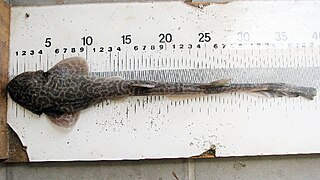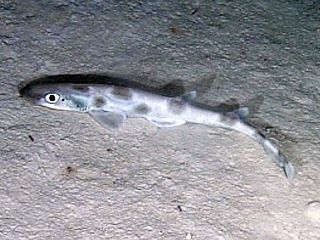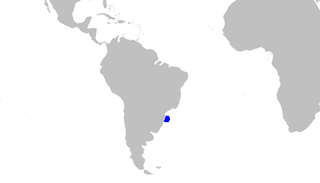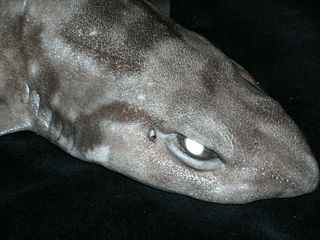
The redspotted catshark, also known as the Chilean catshark, is a species of catshark commonly found in the coastal waters of the southeastern Pacific, from central Peru to southern Chile. They are typically found in the rocky sublittoral areas at the edge of the continental shelf, in waters down to 100 m in depth. They spend the spring, summer, and fall in rocky subtidal areas, but winter in deeper offshore waters due to the strong currents at that time of year.

The brown catshark is commonly found in the Pacific Ocean, ranging from the northern Pacific waters off the coast of British Columbia and south to the Baja California peninsula in Mexico. They may live as far south as Ecuador and Peru. Brown catsharks are deep-water sharks that live on the outer continental shelf and the upper slope. They have been known to live at depths ranging from 30 to 650 m and live on the bottom, usually in muddy or sandy areas. The brown catshark, when originally described, was called Catulus brunneus.

The lollipop catshark is a little-known species of shark belonging to the family Pentanchidae, the deepwater catsharks, and the only described member of its genus. A diminutive, bottom-dwelling shark of the outer continental shelf and upper continental slope, this species can be readily identified by its tadpole-like shape with a greatly expanded, rounded head and narrow body. The large head houses expanded gills, which are thought to be an adaptation for hypoxic conditions. This shark preys on crustaceans and fishes. Reproduction is aplacental viviparous, with females retaining egg cases internally two at a time until they hatch. There is no fishery interest in this species.

The balloon shark is a species of catshark, and part of the family Scyliorhinidae, endemic to the southwestern Indian Ocean off South Africa and Mozambique. Benthic in nature, it is found over sandy and muddy flats at depths of 40–600 m (130–1,970 ft). This thick-bodied species has a broad, flattened head and a short tail; its distinguishing traits include narrow, lobe-like skin flaps in front of the nostrils, and a dorsal color pattern of faint darker saddles on a light grayish background.

The Izak catshark or simply Izak is a species of shark belonging to the family Pentanchidae, the deepwater catsharks. This species is common off the coasts of South Africa and southern Namibia. It typically inhabits the outer continental shelf at depths of 100–300 m (330–980 ft), with the males found deeper than the females and juveniles. The Izak catshark has a short, wide, flattened head and a robust body tapering to a long, slender tail. It can be identified by its ornate color pattern of dark brown spots or reticulations and blotches on a light yellowish background, as well as by the enlarged dermal denticles over its pectoral fins and along its dorsal midline from the snout to the second dorsal fin. This species reaches 69 cm (27 in) in length, with the males larger than females.

The narrowmouthed catshark is a coloured catshark beloning to the family Atelomycteridae, found from central Chile around the Straits of Magellan, to Argentina between latitudes 23° S and 56° S, at depths down to about 180 m (600 ft) in the Atlantic Ocean and about 360 m (1,200 ft) in the Pacific. It can grow to a length of up to 70 cm (28 in). The reproduction of this catshark is oviparous.

The narrowtail catshark is a catshark of the family Scyliorhinidae, found off the coasts of Honduras and Nicaragua, between latitudes 18° N and 10° N, at depths between 190 and 410 m. It can grow up to a length of 35 cm (14 in). The reproduction of this catshark is oviparous.
The lizard catshark is a small shark species of the catshark family, Scyliorhinidae, found off the coast of southern Brazil on the upper continental shelf at depths of between 250 and 500 metres.

The dwarf catshark is a catshark, belonging to the family Scyliorhinidae. It is found off the coast of southern Florida, the Bahamas, and Cuba and is also known as the whitespotted catshark and Cuban catshark.

The quagga catshark is a species of shark belonging to the family Pentanchidae, the deepwater catsharks. A small, slim-bodied shark reaching 37 cm (15 in) in length, it has a distinctive color pattern of narrow, dark brown vertical bars, which resemble those of the quagga. Its head is short and flattened, with a pointed snout tip that is not upturned.

The West African catshark is a catshark of the family Scyliorhinidae. It is found in the eastern Atlantic between latitudes 20° N and 17° S, at depths between 45 and 500 m. It can grow up to a length of 80 centimetres (31 in). At one time, the West African catshark was considered to be a subspecies of the nursehound, Scyliorhinus stellaris, but is now considered to be a separate species. The reproduction of this catshark is oviparous.

The whitesaddled catshark is a species of catshark, and part of the family Scyliorhinidae. It is found on the upper continental slope of the western central Atlantic Ocean, off the coasts of Honduras, Panama and Colombia, between latitudes 22° N and 9° N, at depths between 274 and 457 m. It can grow to a length of 47 cm (19 in). The reproduction of this catshark is oviparous but otherwise, little is known about its biology.

The freckled catshark is a catshark of the family Scyliorhinidae. It is found on the continental shelf and upper slope from the western Atlantic from western Venezuela, Suriname, Brazil, and Uruguay, between latitudes 11° N and 32° S. However, specimens from the northern part of this range probably refer to other species.

The boa catshark is a catshark of the family Scyliorhinidae. It is found on the continental shelves and insular slopes of the Caribbean Sea and the Gulf of Mexico, between latitudes 20° N and 9° N, at depths between 330 and 675 m. It can grow up to a length of 54 cm. The reproduction of this catshark is oviparous.

The roughtail catshark or marbled catshark is a common species of deepwater catshark, belonguing to the family Pentanchidae. It is found at a depth of 36–702 m (118–2,303 ft) in the northwestern Atlantic Ocean, the Gulf of Mexico, and the Caribbean Sea, from North Carolina to Costa Rica. Individuals of different sexes and ages are segregated to some degree. A small species not exceeding 33 cm (13 in) in length, the roughtail catshark has a slender body with a marbled color pattern of dark saddles and spots, and a prominent crest of enlarged dermal denticles along the dorsal edge of its caudal fin. This species feeds mainly on shrimp and is oviparous. It is caught incidentally in shrimp trawls, though trawl fisheries within its range mostly do not operate at the depths it inhabits. As a result, the International Union for Conservation of Nature has listed it under Least Concern.

The Australian sawtail catshark is a common species of deepwater catshark, belonging to the family Pentanchidae, endemic to southern Australian waters. It is found on or near the bottom of the outer continental shelf and upper continental slope, at depths of 85 to 823 m. This slim-bodied species is characterized by crests of enlarged dermal denticles along both the dorsal and ventral edges of its caudal fin and caudal peduncle, along with a color pattern of broad, dark saddles outlined in white. It can grow to 61 cm (24 in) in length. The Australian sawtail catshark feeds mainly on fishes, crustaceans, and cephalopods. Females are oviparous and lay eggs enclosed by capsules. This species is often caught incidentally by commercial bottom trawl fisheries, but is not significantly threatened by fishing activity. Thus, it has been assessed as of Least Concern by the International Union for Conservation of Nature (IUCN).

The longfin sawtail catshark is a rare, little-known species of deepwater catshark., part of the family Pentanchidae. Once thought to be a subspecies of the roughtail catshark along with the Antilles catshark, it inhabits deep water off the Caribbean coasts of Panama and Colombia. This slim-bodied species has a marbled dorsal color pattern and a prominent crest of enlarged dermal denticles along the dorsal edge of its caudal fin. It can be distinguished from similar species by its relatively longer anal fin and small adult length of under 35 cm (14 in). The longfin sawtail catshark is oviparous.

The southern sawtail catshark is a species of deepwater catshark, belonging to the family Pentanchidae, endemic to southern Brazil. It inhabits deepwater reefs on the upper continental slope at a depth of 236–600 m (774–1,969 ft). Reaching at least 43 cm (17 in) in length, this slim-bodied species closely resembles the Antilles catshark. It has a prominent crest of enlarged dermal denticles along the dorsal edge of the caudal fin, as well as a distinctive color pattern of dark oval blotches, outlined in white, along its back. The southern sawtail catshark is oviparous, with females producing reddish egg capsules. The International Union for Conservation of Nature (IUCN) has assessed it as Vulnerable; it is often taken as bycatch and may be threatened by intensifying squid fishing.

The African sawtail catshark is a species of shark belonging to the family Pentanchidae, the deepwater catsharks. Demersal in nature, it is found at depths of 160–720 m (520–2,360 ft) off the western African coast from Morocco to South Africa. This slender species has a rather long, pointed snout, a series of dark saddles along the back and tail, and a prominent crest of enlarged dermal denticles along the upper edge of the caudal fin. Its maximum known length is 46 cm (18 in).

Scyliorhinus meadi, the blotched catshark, is a little-known species of catshark, and part of the family Scyliorhinidae, found in the western central Atlantic Ocean. It inhabits banks of deep-sea coral at depths of 329–548 m (1,079–1,798 ft), feeding on cephalopods, shrimp, and bony fishes. This species can be identified by its wide body and head, and the dark saddle-like markings on its back. It also has small spots that fluoresce yellow under a blue light. Adult blotched catsharks have not been observed; the largest immature specimen is 49 cm (19 in) long. Like other catsharks, it is believed to be oviparous. This species is not dangerous to humans and has no commercial significance.




















